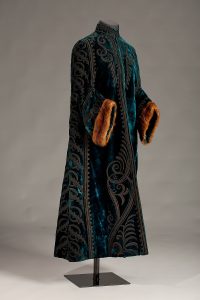There are too few nonprofit organizations like CC fighting for the commons – support our vital leadership with an end of year contribution. Donate today!
Can Open GLAM Reshape the Fashion Heritage Narrative?
CopyrightOn November 2 and 3, 2020, Creative Commons (CC), the European Fashion Heritage Association (EFHA) and the Onassis Foundation held the online symposium: Is Sharing Always Caring?
Bringing together 250 participants from 38 countries on four continents— from museum professionals to fashion design students all the way to big fashion brands—the event was an opportunity to have important conversations about the benefits of open access and the challenges of bringing equity, diversity and inclusion into the policies and practices of fashion heritage institutions and the fashion universe more generally. The symposium’s program spanned two days and comprised presentations, roundtables, and a hands-on workshop.
Background: Openly sharing and caring for fashion heritage is central to GLAMs’ mission
Many GLAMs (galleries, libraries, archives, and museums) are dedicated to making their fashion heritage collections available to the public. For them, providing public access and enabling interactions with this heritage is a core aspect of their mission.

Evening coat made by Louvenia Price (1870-1900) and shared by the National Museum of African American History and Culture (CC0).
The Open GLAM movement, of which CC is a leader, celebrates this mission in the digital environment. This movement is underpinned by the value and responsibility for socially beneficial sharing of cultural heritage and posits that access and reuse of fashion heritage are necessary components of a virtuous creativity cycle.
Nevertheless, the possibilities for online access, sharing, use and reuse of fashion heritage shared online can give rise to some tensions with regard to the heritage of marginalized or under-served communities. These tensions arise because those communities are often excluded from the discussions and decision-making processes about their own heritage. One big concern is the appropriation of fashion heritage made available online without any consultation or involvement of the communities who are the custodians of the heritage in question. In fact, much fashion heritage includes elements that are not just aesthetic or ornamental but that are intimately linked to the identity of their holders and their way of life, history and environment. Sharing those elements without care can result in harm for the communities concerned.
Sharing without caring for fashion heritage can have deep implications that distort the fashion narrative. So, what can GLAMs do to participate in reshaping this narrative?
Part of the issue is that, by default, many forms of fashion heritage, such as designs, patterns, textiles, jewellery, etc. are deemed to be in the public domain under copyright law. As a result, it may seem that such heritage is freely available for access, use, and reuse when in reality, other considerations come into play and govern who can do so and how. Sharing without caring for fashion heritage can have deep implications that distort the fashion narrative. So, what can GLAMs do to participate in reshaping this narrative?
Summary: Exploring the shared ground between sharing and caring
Highlights from Day 1
On the first day, Evelin Heidel aka Scann (Creative Commons) and Ariadna Matas (Europeana Foundation) presented the many advantages for GLAMs in sharing their collections online and showed how Creative Commons’ tools and Rights Statements can help foster an engaging culture of use and reuse of cultural heritage.
Andrea Wallace (University of Exeter) got participants to reflect on who gets to decide what “open” is, what heritage can be made open and who gets to take part in those conversations. Brigitte Vézina (Creative Commons) closed the first day’s speaker session with an overview of what GLAMs can do to share and care to avoid the fashion cultural appropriation trap.
Marco Rendina (EFHA) and Prodromos Tsiavos (Onassis Foundation) then moderated a lively roundtable discussion that also gave participants an opportunity to share experiences and resources.
The program continued with a practical workshop designed as a conversation about some of the benefits and challenges associated with making fashion heritage collections available online. Scann, Ariadna Matas, Brigitte Vézina, and Marta Fransceschini (EFHA) lead breakout group discussions. By looking at real examples of fashion heritage from the Europeana Fashion collection, participants discussed copyright issues as well as questions related to culturally-sensitive materials. Participants could thus collectively reflect upon the ways in which sharing heritage really equates with caring for it.
Highlights from Day 2
On the second day, Monica Moisin (Cultural Intellectual Property Rights Initiative) offered a legal perspective on decolonising fashion, unfair exploitation, and commodification of cultural identities and helped explore what GLAMs can do about it. Hazel Clark (Parsons School of Design) then revisited how fashion is literally the fabric of cultures and looked at fashion identities and how museums can provide mechanisms for cultural production.
Camille Callison (University of Manitoba) gave a poignant account of how “caring” in practice means building relationships to facilitate respectful sharing of Indigenous knowledges. Finally, Janice Deul (Diversity Rules) probed the world of curatorial activism and brought attention to the lack of Black in museum fashion collections. The session concluded with an empowering message about how GLAMs can be catalysts for change and participate in reshaping the fashion narrative by taking a more inclusive and diverse approach in sharing and caring for fashion heritage.
The symposium closed with a roundtable discussion chaired by Marco Pecorari (The New School – Parsons Paris) and Marta Franceschini. In addition to the speakers, it also brought together Filep Motwary (Vogue Greece), Andreea Diana Tanasescu (La blouse roumaine IA Association (Give Credit)), and Eva Losada, fashion photographer. Each speaker brought their own perspective on how to navigate the murky boundaries of cultural appropriation and the need to bring more diversity into the fashion conversation.
Video recordings of all of the sessions are available on EFHA’s Vimeo channel: Day 1 and Day 2. For updates, stay tuned via @creativecommons and @EurFashion on Twitter (#EFHA2020) or reach out at info@creativecommons.org.
Posted 16 November 2020